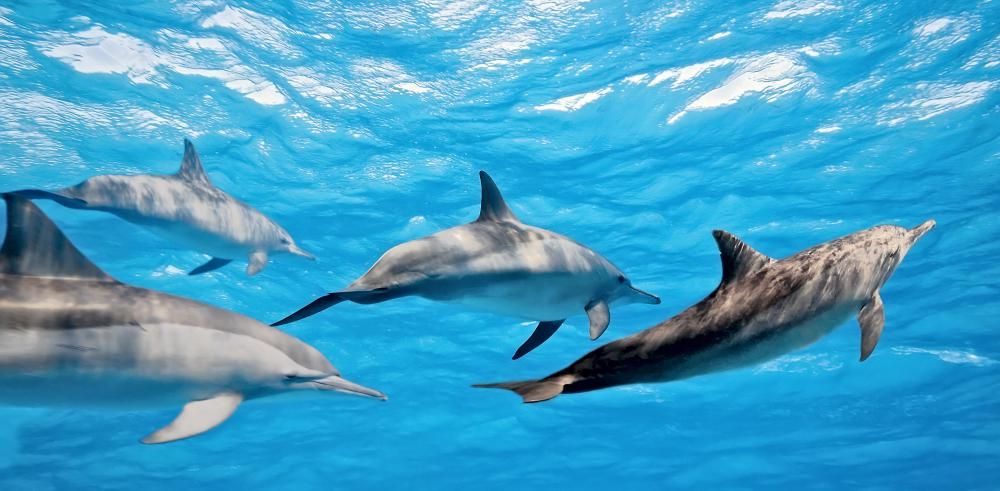At AllThingsNature, we're committed to delivering accurate, trustworthy information. Our expert-authored content is rigorously fact-checked and sourced from credible authorities. Discover how we uphold the highest standards in providing you with reliable knowledge.
What Is the Difference between a Porpoise and a Dolphin?
The difference between a porpoise and a dolphin can be subtle, as they are two closely-related groups of species that are grouped together in the Cetacea order and Delphinidae family along with whales. As of 2011 however, at least 32 species of dolphins have been identified in the wild compared to only six species of porpoise. This is due in part to the fact that dolphins tend to be much more gregarious and receptive to encounters with humans in or near the water than porpoises, making them easier to classify. Dolphins also appear to be more highly social animals that communicate by underwater sounds with their young, whereas porpoises have not been observed to do this.
Physically, the characteristics of a porpoise and a dolphin vary in a few key common areas. The central dorsal fin on most dolphins has a sloping backward shape and inner curve on its back side, whereas a porpoise dorsal fin is a rounded version of the triangular shape that a shark's dorsal fin has. Dolphins are also known to have cone-shaped teeth while porpoise teeth take on a spade shape. Porpoises are one of the smallest groups of cetaceans as well, rarely exceeding 7 feet (2.1 meters) in length. While dolphin sizes vary considerably, they are often over 10 feet (3.05 meters) in length, with the biggest dolphin, popularly known as the Orca or killer whale, reaching up to 32 feet (9.8 meters) in length.

Another key difference between a porpoise and a dolphin is their range of habitat. While the porpoise has only been observed in saltwater ocean environments, there are two broad ecosystems for dolphins, including the larger group of ocean dolphins and a select group of river dolphins. Five species of dolphins are known to live within freshwater river systems. They are usually named after the rivers themselves, and these include such species as the Amazon river dolphin in South America and the Ganges river dolphin in northern India.

The Chinese river dolphin has traditionally made its home in the Yangtze river in China. Unfortunately, it has not been spotted there since at least the year 2006 and has been declared extinct. The difference in how readily a porpoise and a dolphin will approach human boats has led to many dolphins being inadvertently killed by drowning when ensnared in fishing nets, while shy porpoise behavior has protected them from such deadly human encounters.

While the Phocoenidae family of porpoises is characterized by smaller dorsal fins and a more blunt-shaped face than that of dolphins, they are not without their own distinctive features. A porpoise and a dolphin can often be mistaken for each other because they share sometimes confusing traits. The Dall's porpoise is a good example of this. It has the black-and-white patchwork skin that strongly resembles the Orca, while much smaller in size at a maximum length of 7.5 feet (2.3 meters) for an adult, versus 32 feet (9.8 meters) for that of the Orca. An adult Dall's porpoise can weigh up to 350 pounds (159 kilograms) as compared to a newborn baby Orca that weighs about 395 pounds (179 kilograms).
Frequently Asked Questions
What are the main physical differences between porpoises and dolphins?

Porpoises and dolphins differ notably in their facial features and body shapes. Porpoises have shorter beaks and spade-shaped teeth, while dolphins boast longer beaks and cone-shaped teeth. Additionally, dolphins tend to have a more streamlined, elongated body and a pronounced dorsal fin, compared to the smaller, triangular dorsal fin of porpoises.
How do the social behaviors of porpoises and dolphins compare?
Dolphins are famously sociable, often found in large, dynamic groups called pods, which can number in the hundreds. They are known for their playful behavior and complex communication. Porpoises, on the other hand, are more solitary and tend to form smaller groups, usually with just a few individuals, and are generally less boisterous than their dolphin counterparts.
Can porpoises and dolphins interbreed?
Despite being closely related, porpoises and dolphins belong to different families and genera, making interbreeding highly unlikely. They have distinct genetic makeups and behavioral patterns, which serve as barriers to interbreeding. There are no known cases of hybrid offspring between porpoises and dolphins in the wild or in captivity.
What are the conservation statuses of porpoises and dolphins?
The conservation status of porpoises and dolphins varies by species. According to the International Union for Conservation of Nature (IUCN), some species like the vaquita, a type of porpoise, are critically endangered, while others like the bottlenose dolphin are considered to be of least concern. Conservation efforts are ongoing to address threats such as bycatch, habitat loss, and pollution.
How do porpoises and dolphins communicate?
Dolphins are renowned for their advanced communication skills, using a complex mix of whistles, clicks, and body language. They have been observed to have signature whistles, akin to names. Porpoises, while less studied, also communicate using sounds, but their vocalizations are typically less varied and not as well understood as those of dolphins.
Where can you typically find porpoises and dolphins in the wild?
Dolphins are widespread and inhabit a variety of marine environments, from coastal to open seas, and some species even venture into freshwater rivers. Porpoises, in contrast, are primarily found in coastal and northern waters, with a preference for colder temperatures. Both are found in all oceans, but each species has its own preferred habitat.
AS FEATURED ON:
AS FEATURED ON:














Discuss this Article
Post your comments